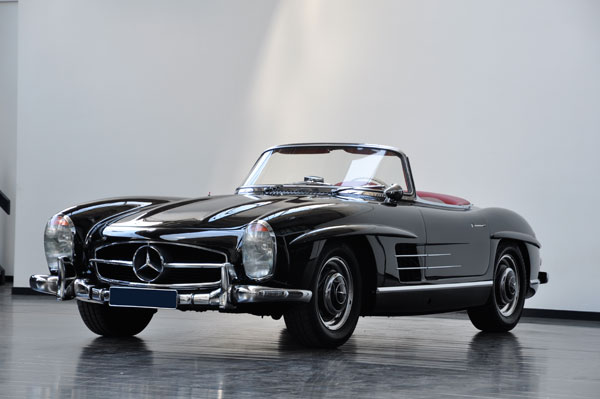SCM Analysis
Detailing
This car, Lot 252, sold for $752,130, including buyer’s premium, at the Artcurial Automobiles Sur Les Champs auction in Paris on June 13, 2011.
I’ve done a number of SCM auction profiles on Mercedes-Benz cars over the years. When I accepted this assignment, I decided to go back to the SCM December 2006 issue, where I did the profile of another 1957 Mercedes-Benz 300SL Roadster that sold at RM’s 2006 auction in Monterey, CA. The headline on the cover read, “We say $400,000—The market speaks at $605k.”
That was a watershed moment for Mercedes-Benz 300SLs. I don’t think I’d ever received as many calls and comments about anything I’d ever written before. The calls ranged from people who were looking for a 300SL to owners stating that they too had always wondered why their cars seemed so undervalued in comparison to its contemporaries, particularly Ferraris.
A fun, reliable classic
At our shop, I have the unique opportunity to test drive any number of iconic European sports cars on an almost-daily basis. I’ve driven the Ferrari GTO, Ferrari 275, Aston Martin DB4, Jaguar XKSS, BMW 507 and so on. All of them are fantastic cars, and ones that any one of us “true believers” would want in our garage.
But if someone said, “Okay, pick one, and let’s drive it to San Diego today,” that one would be a 300SL—without a doubt. Why? For one reason alone: I know I’d make it there!
In the interest of full disclosure, I want to state right up front that I’m a German car guy, first and foremost. I was weaned on early VWs, and I progressed to 356s, 300SLs, and early 911s, and they are my love. In their day, there was absolutely no equal in engineering, fit, or finish.
This is my humble opinion, of course. But, because of my unique perspective, I get to see these other icons on the operating table, so to speak.
You’d be appalled at some of the things you see when you get down to the core of many cars. Most small European manufacturers farmed out a lot of their subcontract work. The chassis was built one place, the coachwork in another, and there were wildly different levels of quality.
Not so with Mercedes-Benz, as everything was done in house to exacting measures. Enough of my drum beating for 300SLs, but you get the point.
I can guarantee you that any major car collection in the world would have a 300SL Gullwing or Roadster—or maybe both. Look at any of the über-popular 1,000-mile tours around the world, and I bet that the 300SL would be the most prolific car there. Why? Because they look great, sound great, and are dead reliable.
Expensive even 50 years ago
Of the 1,858 Roadsters built, 618 were built in 1957. Production numbers progressed downwards from there, until only three were built in late 1963 and delivered in 1964. Remember, these were $11,000 cars, when a comparable 1957 Corvette listed at $3,176, and a fully optioned Corvette Fuelie would be hard pressed to make it over $4,000. These 300SLs were seriously expensive cars in their day, and that is one of the reasons you still see so many low-mileage examples. They weren’t daily drivers or second cars—but an expensive toy that got driven infrequently at best.
The pecking order for 300SL Roadsters is as follows: Disc brake/alloy engine cars are the most desired, while disc brake/cast iron engine cars trail behind. In terms of model year, 1957 Roadsters are tops, with 1958 to 1960s cars bringing up the rear. 1957 through 1960s Roadsters are essentially the same car—with minor mechanical differences—but the ‘57 brings more because it was the first year.
Soaring values—and restoration costs
In preparing for this article, I went back to the December 2006 SCM to compare figures. The $300k to $350k, 3,000-hour restoration is now closer to $400k to $450k. The hard top at $7k to $10k is now $15k to $20k, and the factory luggage that was $7k to $10k is now over $20k.
Rising costs for parts and subcontractors have made restoration prices skyrocket. And it takes about 12 to 14 months to restore a car—once you get it in the shop. We are now on an 18-month lead time for a body-off restoration.
Auction results can be very difficult way to compare values. All you need are two people who want the same thing, on the same night, to throw common sense out the window. Think of the steel-bodied Gullwing that sold at RM’s 2011 Arizona sale for $1.3m. That sale could not have been re-created the very next day in the real world. That one sale did not make steel-bodied Gullwings million-dollar cars—although I believe they will be.
Having said that, I believe this Roadster—on this night, in these colors, at this level of quality—was well bought.
When you do the math of what it would cost to buy the donor car, do the restoration with these options—and in what time frame—the buyer just saved at least a year.
(Introductory description courtesy of Bonhams.)
